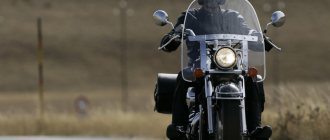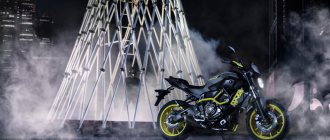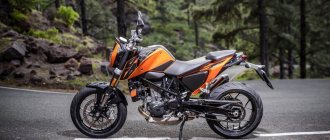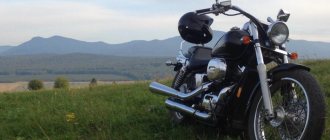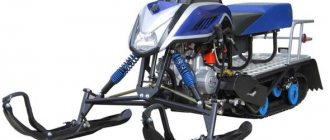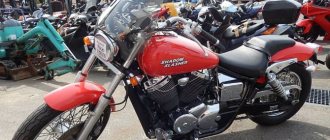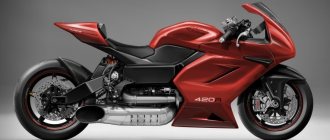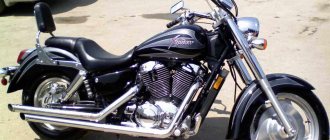| Honda NV750 Custom (1983-1985) | Honda NV750 Shadow (1986) | Honda VT750C Shadow ACE (1997-2001) |
| Honda VT750CD Shadow Deluxe (1998-2003) | Honda VT750DC Shadow Spirit (Black Widow, Slasher) (2000-2007) | Honda VT750C Shadow Aero (2004+) |
| Honda VT750C2 Shadow Spirit (2007-2015) | Honda VT750C2B Phantom (Black Spirit) (2009+) | Honda VT750S / VT750RS Shadow RS (2010-2013) |
Honda Shadow 750 Cruiser Series
begins its history in 1983 and the appearance of the
Honda NV750 Custom
, which was available in the markets of North America and Japan.
In 1986, the motorcycle changed its name to Shadow 750
, being updated technically and visually. The model of that time was quite heavily boosted (which is typical for all Japanese cruisers of those years), producing up to 66 hp. power. These versions are present at Japanese auctions, but due to their age, there are not many of them.
In 1997, the first version with the name Honda VT750 Shadow
in the American Classic Edition (ACE) modification, which began the rapid growth of the model’s popularity. The modification featured classic American features with deep fenders, wide spoked wheels and chain drive. At the same time, an internal Japanese modification was released - the Honda Shadow 400.
In 2000, the Shadow 750 line was replenished with a new modification - Honda VT750DC Shadow Spirit
.
In Japan it was sold under the name Slasher
, and in Europe -
Black Widow
. The model featured short fenders, a thin 19′ front wheel and a smaller fuel tank (13 liters instead of 14 liters in the ACE). Otherwise, the motorcycle was equipped with the same engine, chain drive and two carburetors.
In 2003, the Honda VT750C Shadow ACE modification finally left the market, giving way to the new Honda VT750C Aero
. The new model received many technical changes regarding ergonomics, overall dimensions, front suspension, engine, intake system (using one carburetor instead of two) and drive (instead of a chain, the model received a cardan and changed gearbox ratios).
In 2007, the Honda VT750DC Shadow Spirit (Slasher, Black Widow) modification left the market, giving way to the new Honda VT750C2 Shadow Spirit
. The model visually resembles the previous modification, but is equipped with a 21′ front wheel, electronic fuel injection (since 2008, 1 carburetor in 2007), cardan drive and a 14-liter tank. The Aero modification gets an injector.
In 2009, another modification appeared - Honda VT750C2B Phantom
.
In some countries it was sold under the name Black Spirit
. Despite the similarity of the name with the Honda VT750C2 Shadow Spirit, the Phantom modification is not related to it, but is a version of the Aero in black, straight handlebars and short fenders. The Aero modification includes versions with ABS.
In 2010, another modification was introduced - Honda VT750RS Shadow
.
In the Japanese market it was sold as the Honda VT750S
. Visually reminiscent of the classic Honda VRX400. The Shadow 750 differs from the entire line in its shortened wheelbase, increased seat height, increased ground clearance, practically the lowest curb weight (second only to the NV750 Custom), a 10-liter fuel tank and a chain drive.
In 2013, the RS modification leaves the market, and the Honda VT750C2 Shadow Spirit receives a version with ABS (designated VT750C2S). 2015 was the last year of production of the Honda VT750C2 Shadow Spirit modification.
Currently, only the Aero and Phantom versions are present in the production line.
The main competitors of the Honda Shadow 750 in the class:
- Kawasaki VN 750 Vulcan / Kawasaki VN 800 / Kawasaki VN 900
- Suzuki Boulevard C50 / Suzuki VZ 800 Marauder (Desperado) / Suzuki VS750 Intruder
- Yamaha XV 750 Virago / Yamaha XVS 650 Drag Star
Design
All the numerous modifications of the Honda Shadow 750 look more or less similar, a classic – it’s a classic in Africa too. The earliest model, the NV750, and the VT750RS, which is somewhat reminiscent of the VRX400 and is a kind of nod to classic retro motorcycles, stand out. In any case, the adoration of millions of bikers suggests that Japanese designers worked 100% for their salaries.
Photo gallery
We present to you the best photos of the Honda Shadov VT750C cruiser. They are structured in such a way that they present the model from different vantage points. In the gallery you can examine the features of the frame of this bike and other components, which will help form an idea of the motorcycle.
Specifications
At the end of the last century, a general reduction in the cost of production began along with the tightening of environmental standards, so the old Shadows are noticeably more powerful than the newer ones. So, the NV750 had a 66-horsepower engine, and the first VT750C, model 1986, had a 60-horsepower engine. But all their followers sharply lost power , which is 42-45 hp. , so, paradoxically, modern Shadow 750s have more modest characteristics than the old ones.
Engine
Until 1968, a V-twin with a classic 45° cylinder angle was installed, but there are almost no such old bikes on sale. And on all Honda Shadow 750 released in 1987 and later, the engine is completely different. This is a 745 cc liquid-cooled V-twin with 3 valves per cylinder , one or two carburetors (from 2008 - with injection) and either a chain or cardan drive, depending on the modification. Maximum speed – 160 km/h (180 km/h for the RS version), acceleration from 0 to 100 km/h – about 7 seconds , torque – from 59 to 69 Nm.
Transmission
All versions of the cruiser received the same 5-speed transmission . In the 80s, this was not bad, because competing models sometimes still had 4-speed gearboxes. But what prevented the designers from transferring the KPP-6 from the NV750 is absolutely unclear. It is also unclear why it was necessary to replace the cardan with a chain. The cardan drive later returned, but all modifications currently produced are equipped with a chain.
Chassis and brakes
The best front brakes, double-disc, were installed on the NV750, but then the Japanese decided to save money. Starting in 1986, this model was equipped with a single-disc 296 mm disc with a 2-piston caliper, and an ancient “drum” was installed on the rear wheel. Fortunately, in 2009 it was replaced with a disc brake an ABS system was added , which came in handy.
Electronics
All of it can fit in a small bag from the nearest Pyaterochka. Were there a lot of electronics in motorcycles half a century ago? The Honda VT750C has about the same amount of it, and there is nothing more complicated than a generator, a battery and a switch in which all the wires converge. Although the latest European versions even have a standard immobilizer!
Weight and dimensions
Dry weight ranges from 211 to 246 kg , and curb weight - from 225 to 263 kg . Despite the impressive figures, the motorcycle does not seem heavy, because the lion's share of its weight falls on the engine, located at the very bottom . In terms of size, the Honda VT 750 is closer to “four hundred” than to “liter”, making it really convenient to drive around the city.
Controllability
It’s hard to expect impressive maneuverability from an old-fashioned cruiser, but the brainchild of Japanese engineers can surprise here too. Of course, this chopper is inferior in handling to classics and sportbikes, but it still steers much lighter than its heavier counterparts, and feels great even in dense city traffic.
Fuel consumption
Thanks to the engine developed almost four decades ago, the Honda VT750C is not at all demanding on fuel quality, especially on carburetor (until 2008) versions. But with carburetors it is more voracious, and the average consumption is about 5 liters compared to 4.3 liters for injection modifications.
Road testing of the Honda Shadow Spirit 750 motorcycle
Today, for example, we're in awe of how the Spirit navigates hairpin turns and ridges during a day trip along the switchbacks around Death Valley, the deepest depression in the United States. Yesterday, on a longer, more relaxed walk through the same valley, we winced as the steep, demanding saddle hit our butts. Or is it because we smelled chocolate croissants over the weekend? Shadow or spirit? We scratch our heads in complete confusion.Casting a shadow But we are not completely besotted. After all, it is clear as day that the Spirit is positioned as a response to the popular 650 V-Star model from Yamaha. However, Honda is styled more aggressively: it is a street fighter in comparison with Yamaha's more representative and sophisticated SUV. But in terms of engine and price, Yamaha has something to worry about - the Spirit has a larger engine and the same price as the 650 V-Star.
Although the Spirit's base engine design is similar to the Honda 750's twin-cylinder V-twin engine, its design and wide range of gear ratios set it apart from the ACE 750 and ACE 750 Deluxe variants. The Spirit also has a more pronounced minimalist approach than the ACE, with its austere, larger 19-inch wheels and rugged look. You perceive Spirit almost as a good old friend.
He, but not him
Officially, the Shadow Spirit is a 2001 model, expanding Honda's stable of mid-range cruisers to three examples. This 750 gets a new frame and a new fork with a more radical rake, all along with traditional spokes on a narrower front wheel. At the rear, the bike features chrome adjustable shock absorbers and a shortened rear fender to highlight its street character. Based on Honda's twin-cylinder 52-degree V-twin engine, the Spirit's otherwise nimble engine inherits the sluggish temperament of the 750cc powerplant. The bike has impressive low-end torque in lower gears. And like other Honda Shadow models, from the 600 VLX to the popular 1100 and 1800 VTX, this engine features two-plug, three-valve cylinder heads with two intake valves and one exhaust valve. Quiet, maintenance-free camshaft chain adjusters allow it to run uncannily smooth and quiet.
However, this powerplant isn't some conversion: the 745cc engine offers good acceleration with significantly quicker throttle response than its predecessors. Power delivery is predictable and smooth right from idle, and the 36mm Keihin diaphragm carburetors now feature a new pre-heating system that improves ride quality and ensures easy starting in cold weather. An aluminum radiator with cooling fan maintains a constant engine temperature. The 296mm disc brake provides a strong grip for the dual-piston caliper, slowing you down when you get over the speed limit. What's good is that the operation of the 180-mm rear brake drum is barely audible. The clutch seemed light and reliable to us, but there was a problem with inconvenient engagement at the end of the lever stroke. Fortunately, this is easily remedied by simply adjusting the lever. The five-speed transmission delivers smooth, crisp gear changes, and the chain drive, while potentially unreliable, doesn't detract too much from the experience. However, at full load, overtaking a long vehicle on steep climbs will be a gamble.
Yin and yang On freshly laid asphalt, the Spirit's suspension almost does not react to unevenness, providing such a smooth ride that you can safely fall asleep. However, on older, rougher highways, this design jams bumps into your insides as well as Mike Tyson. While the harsh potholes around town are too much for your bony butts to handle, the rear dual shocks offer a comfortable 90mm of travel with five pre-adjustment positions and a modern internal valving system that lets you dial in the settings you want. We recommend that you take the time to make these adjustments right away - the difference can range from a blissful smile to delighted squeals. The Spirit is also 4.5 kilograms lighter than the ACE, possibly due to fewer body kits. The 41mm front fork gives another comfortable 12.5 centimeters of travel, and the square-tube spine frame incorporates welded components with a durable cast head tube.
Durability can come in handy when you're running at high speed. We found the Spirit to be solid through tight corners, surprising us with its robust handling. The lean angle of the bike when cornering is also very pleasant, with the footpeg rarely touching the asphalt, even at a deep lean. The long and bespoke fuel tank may look tiny, but it holds 13.6 liters of petrol. After 170 kilometers you begin to frantically look for an inconveniently located faucet. We found the 5 liter reserve to be generous enough. He helped us out in a difficult situation on one of our trips to the fatal Valley of Death. We squeezed more than 30 miles out of reserve to the next gas station. But we do not recommend repeating this. Especially in Death Valley...
But we considered the shape of the tank to be unsuccessful. Its edges cut into my legs. It should be rounded at the junction with the saddle for a more comfortable position for the driver. The fuel valve is not located well - next to the saddle, far from the fuel tank.
Leave your wife at home
If you're taking the Spirit on an overnight trip to the coast, do yourself a favor and limit your luggage to a backpack. There is very little space for attaching luggage at the back. And the narrow, angled dragster seat will have you fidgeting after just an hour on the road. The saddle height is a Lilliputian 67.5 centimeters - the lowest in this class. This is good for shorter and/or novice riders, but some of the larger testers reported discomfort with the briefs cutting between their buttocks. However, we suspect it's just poorly fitting underwear, as we found short trips around town relatively pleasant on the body.
Ergonomically, it's a fairly small bike: the backward-sloping handlebars and small, low seat can cause even those over 180cm to hunker down and sit closer to the handlebars than they'd like. The footpegs force you to stretch your legs forward, which is comfortable when driving on the motorway, but proves awkward in city traffic when you need to quickly change gears. The narrow, semi-reclining steering wheel is mounted on rubber cushions, which dampen vibration and make walking around the city pleasant. Its positioning also reduces air resistance at high speeds, so you don't have to spread out like a big sail. But those same narrow handlebars can become loose during low-speed maneuvers due to the bike's aggressive lean.
As for the rear seat, we can't say that the Spirit is designed to carry passengers. The saddle is miniature and almost eliminates the possibility of taking a companion taller than Dr. Ruth. The passenger footrests make you squirm, and we can't imagine anyone willingly agreeing to such inconvenience.
Looks good
We like this motorcycle in terms of style. The profile is spare and clean, and many of our employees have been seen taking an interest in Spirit's appearance. One reviewer noted that the Spirit could pass for a Harley-Davidson Sportster (from a distance, in the dark, and with one eye closed, of course). Be that as it may, such a thought could have come from the Spirit's oval air filter. But when you get closer, you will see that, unfortunately, it is made of plastic. And this is one of the big drawbacks of this bike - a lot of the stylish parts are made of tasteless, cheap material, which only detracts from its appearance. And one more involuntary reminder of Harley: the Spirit's large round rear-view mirrors also vibrate at high speeds—the reflection in them resembles a hallucination. The wobbly 2-into-2 exhaust pipes, however, score points for style and produce a nice high-pitched rumble. The cylinder fins are well polished and the stylish stubby rear fender further enhances the bike's street character.
Unlike the previous American-assembled Honda 750, the instrument panel (analogue speedometer and LCD odometer) is housed in a beautiful chrome-plated housing located on the fuel tank, which visually gives the bike a solid look, but makes it difficult for the driver to see the instruments. For greater safety, there is a steering column lock, and the footrest can be easily raised and retracted. The controls are at your fingertips and gear changes are a breeze. The choice of colors for 2001 is small: only pearl white and black. Our test unit was black.
Honda also offers outstanding after-sales service for the Spirit, along with a host of optional accessories including a nifty headlight visor, leather saddle, backrest and solo seat covers, and much more.
It's possible that the Shadow Spirit will appeal to serious drivers looking for not only a solid vehicle, but also some weekend fun; and also suitable for confident beginners who crave a fast ride. The low-slung seat, predictable power delivery and friendly handling make this bike a comfortable ride, and its peppy engine is an enjoyable ride. And there is no need to find out in detail the origin of the name of this motorcycle. We'd rather just ride it.
Repair and tuning
Any modification of the Honda Shadow VT750C can be serviced or repaired independently without any problems. Over the past decades, practically nothing has changed in the design of this motorcycle, so, armed with a manual, any biker who has at least once tinkered with a Ural or other fiend of the Soviet motorcycle industry in the garage can easily figure it out.
Repair
If there are no serious problems, there is no need to take the motorcycle to a motorcycle service center - there is nothing in it that cannot be repaired in a garage. And if you look after it well, then serious problems will not arise. Fortunately, the Honda VT750C does not have any connectors for connecting to a laptop with proprietary dealer software - only good old hardware.
Spare parts
You can always order any necessary spare parts through official dealers. Why order? Because they usually have nothing in stock except consumables, but thanks for that. For already discontinued modifications like the NV750, you can find everything you need in online stores like Megazip and Exist, but in this case it is advisable to know the number of the required part, and not just its name.
Tuning
Whatever your heart desires! Seats, trunks, trunks, backrests, windows, turn signals, headlights... There are both branded parts from famous foreign manufacturers, and a bunch of cheap tuning from China, so every owner of a Honda Shadow 750 can easily find something to suit their taste and budget.
Motorcycle modifications
- Honda NV750 . The very first version, produced from 1983 to 1985. It has the most powerful engine (66 hp), and is almost never found on sale due to its advanced age. It was equipped with a cardan and a 6-speed gearbox.
- Honda Shadow 750 ACE (American Classic Edition), 1997-2001. Chain drive wheels, a 14-liter gas tank, deep fenders, a heavy appearance and one balancer shaft instead of two, so that American bikers enjoy the vibrations that are so dear to their hearts.
- Honda Shadow 750 Aero . Produced from 2004 to the present. Equipped with a cardan drive.
- Honda Shadow 750 Phantom . No different from the Aero, except for the matte black color scheme. Still in production today.
- Honda Shadow Slasher 750, Black Widow in some markets. It is a slightly modified Honda Shadow ACE, but with a thin front wheel of increased radius and a gas tank reduced by 1 liter. Produced from 2000 to 2007.
- Honda Shadow VT750RS . Outwardly, it resembles a hybrid between a cruiser and a classic road motorcycle; the differences are clearly visible in the photo. It features the smallest gas tank - 10 liters and a direct fit. The model was not popular, and therefore was produced only briefly, from 2010 to 2013. The wheel drive is a chain.
History of changes
During its long journey, the bike went through the following stages:
- 1986 – Custom changes its characteristics and becomes Shadow 750;
- 1997 – the BT 750 C Shadow A.S.E. version appeared;
- 1998 - Shadow 750 A.S.E. version appeared. Deluxe;
- 2006 – an immobilizer was added to the kit;
- 2007 – the BT 750 C2 Shadow Spirit version appeared;
- 2009 – the VT 750 S2B Phantom version appeared;
- 2010 – the VT 750 RS Shadow RS version appeared;
- 2011 is the last year of production of the Shadow 750.
The motorcycle is a successful representative of the class that will suit most connoisseurs of classic mid-power cruisers.
Advantages and disadvantages
You need to be careful when judging the strengths and weaknesses of the Honda VT750 Shadow motorcycle. After all, its design was developed almost 40 years ago, and since then it has not undergone significant changes. This is not the stinginess of Japanese engineers, this is exactly what avid chopper riders need - a simple “iron” cruiser with a minimum of technical complications.
Advantages
- A sea of affordable tuning . In foreign online stores you can find whatever you want for sale. There are no problems with spare parts either.
- Excellent reliability of all main components. Minor breakdowns do occur on older copies, but overall the Honda VT 750 Shadow enjoys the reputation of “a motorcycle that doesn’t break down” and is deservedly so.
- Ease of operation . The low center of gravity does its job, and subjectively the bike seems light and easy to control.
- Moderate appetite . Even at high speed, the Honda Shadow 750 is not particularly gluttonous.
- Ease of maintenance and repair . This model is as simple as a brick, and understanding its structure will not be difficult.
Flaws
- Weak light from the standard headlight, which does not provide adequate visibility at night. This problem is common to most motorcycles.
- Small gas tank volume , from 10 to 14 liters.
- Rigid and primitive suspension without any adjustments.
- Due to the low power, the presence of a passenger and cargo negatively affects the acceleration dynamics and the length of the braking distance.
Estimated cost
The 750 cc motorcycles of the legendary Shadow line were undeservedly forgotten at one time , without really having time to “light up” due to some duties.
But time has passed and this motorcycle is again in this line.
You can now find new 750 cc motorcycles in the Shadow line at dealers. But they won't be very cheap.
For the VT750DC Shadow Spirit model you will have to pay a little more than 800,000 rubles. And the VT750DC Shadow Black Spirit model will cost even more, about 825,000 rubles.
Despite the long period in which a motorcycle with an engine of this size was not produced, this model is still quite common and there are more than enough offers for it on the secondary market.
The prices for it are very varied , since the cost takes into account technical equipment. condition and performance of the motorcycle, its year of production.
So, on the secondary market, a Honda Shadow with a 750 cc engine. cm can be found with a price from 100,000 to 600,000 rubles.
Are you interested in the top speed of the Honda CB 400? You can find out this, and more, from our article about this motorcycle model.
This motorbike manufacturer has in stock models of all categories of motorcycles. Let's look at the most popular of them in our publication.
Owner reviews
I rode it for two seasons, sold it for the most common reason - I wanted to increase the cubic capacity, and eventually switched to a VTX 1800. I can’t even compare these two motorcycles, the difference in volume is double, but I have only the most pleasant memories of Shadov. It steers like a bicycle, where you have to maneuver carefully on Vtyksa, Shadovka flew by with a whistle. When I drive in traffic jams, I even regret that I sold it, but on the highway it doesn’t have enough power. Artyom, Moscow.
Pepelats is indestructible, I bought a 2004 Honda Shadow Aero lying on both sides, took it for ridiculous money - 180k. To put it in order, it took about 30k in cosmetics (complete repaint, new chrome parts), another 17k or so in maintenance - bearings, fluids, seals with anthers and other rubber bands, and other little things. I bought it in 2012, I still drive it, during this time I have covered almost 40k, only the clutch has been repaired. I immediately bought a reinforced one on Ebay, at the same price as the original, but, according to reviews, it lasts much longer. I don’t plan to increase the capacity, I don’t have the money to maintain a Harley, but for 750 W the parts are cheap, and it doesn’t consume much. Vasily, Lipetsk.
I’m driving the ACE for the second season, before it there was a 150 cc Chinese, which was sold long ago and forgotten like a bad dream. I like everything except the vibrations, the model is for the American market, there is no balancer, it shakes mercilessly at idle. And my pants are full of joy, together with my wife and two backpacks we covered almost 25 thousand km over the last season, we drove to Serbia and Montenegro, the motorcycle did not let us down even once. Even with such a load, it goes confidently along the mountain serpentines. Anton, Novorossiysk.
Similar models
- Kawasaki VN750, VN800 and VN900 Vulcan . Not a bad motorcycle, also with a rich history. The 900 cc model has impressive dimensions.
- Suzuki VS750 and VS800 Intruder . A time-tested bike, styled like an old-school chopper. Here we can also mention the Intruder C800, also known as the C50, which replaced it, and with it the Intruder M50 (M800).
- Yamaha XV750 Virago (corresponding to early Honda VT750) and XVS 650 Drag Star. It looks beautiful, costs moderately, and drives quite cheerfully.
FAQ
- Is it possible to stick an old full-power motor into the frame of a new model? No, both the frames and engines are different, so such a conversion is impossible without a deep rework of the entire motorcycle. But this is expensive and pointless; it’s easier to just buy a “liter” right away.
- What is the real maximum comfortable speed for the engine to work without strain? About 130-140 km/h. But already at 150 km/h the engine screams so loudly that you feel sorry for it.
- Are spare parts interchangeable between different modifications? 50/50, depending on the year of manufacture and what specific spare part we are talking about. For example, you can transfer a fork from an Aero to a Spirit, but then you will have to change the front wheel as well. But their seats are different, they differ in fasteners.
Flaws
Different models may have different disadvantages, but for the Shadow 750 users highlight several:
- Low ground clearance . Among the 10 models there was no car with a high seating position, but this is not typical for a cruiser.
- Pendant . Not only does its performance drop with the release of new versions, but there is also no way to adjust it for the road.
- Price of parts and components.
and dignity
You can ride this bike with equal confidence on highways, city streets, rough roads, and even on dirt roads in dry weather.
The advantages included:
- Americanized design . Even the Phantom has plenty of glitter.
- Hydraulic compensators do not require clearance adjustment.
- Controllability.
- Maneuverability.
- Good dynamics for such a giant.
- Ideal weight distribution (For the sake of this quality, the concern went through developments several times, everything was revised, right down to the position of the brackets on the brake discs).
The main advantage that all owners note is the battery. Regardless of the outside temperature, the bike starts in any weather.
Conclusion
In its class, the Honda Shadow 750 can be called one of the best . In terms of weight and controllability, it is close to the “four hundred”, and in terms of dynamics – to the “liter”. This balance, coupled with phenomenal reliability , affordable price and a ton of tuning, ensured the model such a long life. This chopper is equally suitable for driving around the city and for long trips . With timely maintenance, it will serve the owner for years without problems or breakdowns, for which it is valued in many countries around the world, and its technical characteristics are sufficient for any purpose.
Specifications
| Maximum engine power: | 42 - 45 HP |
| Torque: | 59 - 69 Nm |
| Working volume: | 745 cm3 |
| Motor type (cylinder arrangement, number of strokes): | 2-cylinder, 4-stroke, V-shaped |
| Number of cylinders: | 2 |
| Number of valves: | |
| Intake type (Injector / Carburetor): | |
| Bore and stroke: | |
| Starting system (Electric starter, kick starter): | |
| Maximum speed in km/h: | 160 – 180 km/h |
| Cooling system: | Liquid |
| Transmission (gearbox): | 5 |
| Clutch (Dry / Wet): | |
| Drive unit: | chain/cardan (depending on version) |
| Frame: | Steel |
| Chassis | |
| Suspension (front/rear travel): | |
| Brakes (Front/Rear): | |
| Wheels / Tires / Rubber: | |
| Dimensions and weight | |
| Dimensions (Length / Width): | |
| Seat height: | |
| Ground clearance: | |
| Curb weight: | |
| Wheelbase: | 1640 mm |
| Weight: | 238 kg |
| Fuel tank capacity: | 14 l. |
| Battery capacity: | |
| Year of release: | |
| Country of Origin: |


